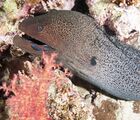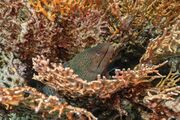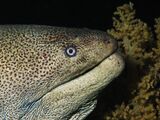Biology:Giant moray
| Giant moray | |
|---|---|

| |
| Scientific classification | |
| Domain: | Eukaryota |
| Kingdom: | Animalia |
| Phylum: | Chordata |
| Class: | Actinopterygii |
| Order: | Anguilliformes |
| Family: | Muraenidae |
| Genus: | Gymnothorax |
| Species: | G. javanicus
|
| Binomial name | |
| Gymnothorax javanicus (Bleeker, 1859)
| |
The giant moray (Gymnothorax javanicus) is a species of moray eel and a species of marine fish in the family Muraenidae. In terms of body mass, it is the largest moray eel; however, the slender giant moray is the largest in terms of body length.[2]
Description
As the name suggests, the giant moray is a large eel, reaching up to 3 m (9.8 ft) in length and 30 kg (66 lb) in weight.[3] Its elongated body is brownish in color. While juveniles are tan in color with large black spots, adults have black specks that grade into leopard-like spots behind the head.[4]
Distribution and habitat
The giant moray is widespread in the Indo-Pacific region, being found from eastern coast of Africa, Red Sea included, until the Pitcairn group, Hawaiian Islands and also Polynesia. North to south Japan and south to New Caledonia, Fiji and the Austral Islands.[5]
It lives in lagoons and on the outer slopes of coral reefs. During the day, it sits sheltered in crevices between 1 and 50 meters deep.[6]
Biology
The giant moray is carnivorous and nocturnal, hunting its prey within the reef. It is known to engage in cooperative hunting with the roving coral grouper (Plectropomus pessuliferus).[7] These two fish species are complementary hunters: While the eel hunts in the reef, it may scare prey up and out of the reef, leaving them to be eaten by the grouper. Similarly, the grouper hunting above the reef may cause prey to attempt to seek refuge in the reef, where the moray may ambush them.
The giant moray mainly feeds on fish and occasionally on crustaceans.[8] This moray eel was recently identified as a natural predator of the lionfish (Pterois miles) in its native habitat in the Red Sea.[9] A mature giant moray has few natural predators, although it may compete for food with reef-dwelling sharks.[10] Cleaner wrasses are commonly found in its presence, cleaning the interior of its mouth.
Gymnothorax javanicus have been shown to have very small optic tectum volumes, indicating that they primarily hunt by smell rather than vision.[11]
Hazards
This species may be hazardous to people. Being at the top of the food chain, it has been known to exhibit biomagnification of harmful ciguatera toxins.[12][13] Eating a giant moray, especially the liver, can thus cause illness, coma, or even death. While this moray may bite if threatened, cornered or in the presence of food,[2][4][14] it is not usually aggressive.
Gallery
Giant moray with cleaner wrasse
Getting cleaned
References
- ↑ Smith, D.G.; McCosker, J.; Tighe, K. (2019). "Gymnothorax javanicus". IUCN Red List of Threatened Species 2019: e.T195741A2410981. doi:10.2305/IUCN.UK.2019-1.RLTS.T195741A2410981.en. https://www.iucnredlist.org/species/195741/2410981. Retrieved 20 November 2021.
- ↑ 2.0 2.1 Lieske, E. and Myers, R.F. (2004) Coral reef guide; Red Sea London, HarperCollins ISBN:0-00-715986-2
- ↑ Lieske, E. and R. Myers, 1994. Collins Pocket Guide. Coral reef fishes. Indo-Pacific & Caribbean including the Red Sea. Harper Collins Publishers, 400 p.
- ↑ 4.0 4.1 Froese, Rainer and Pauly, Daniel, eds. (2007). "Gymnothorax javanicus" in FishBase. 5 2007 version.
- ↑ Fricke, R., 1999. Fishes of the Mascarene Islands (Réunion, Mauritius, Rodriguez): an annotated checklist, with descriptions of new species. Koeltz Scientific Books, Koenigstein, Theses Zoologicae, Vol. 31:759 p.
- ↑ Kuiter, R.H. and T. Tonozuka, 2001. Pictorial guide to Indonesian reef fishes. Part 1. Eels- Snappers, Muraenidae - Lutjanidae. Zoonetics, Australia. 302 p.
- ↑ "Interspecific communicative and coordinated hunting between groupers and giant moray eels in the Red Sea". PLOS Biol. 4 (12): e431. Dec 2006. doi:10.1371/journal.pbio.0040431. PMID 17147471.
- ↑ Kuiter, R.H., 1998. Photo guide to fishes of the Maldives. Atoll Editions, Victoria, Australia. 257 p.
- ↑ Bos A.R.; Sanad A.M.; Elsayed K. (2017). "Gymnothorax spp. (Muraenidae) as natural predators of the lionfish Pterois miles in its native biogeographical range". Environmental Biology of Fishes 100 (6): 745–748. doi:10.1007/s10641-017-0600-7. https://www.researchgate.net/publication/322571037.
- ↑ Prasetyo, Andhika; Simpfendorfer, Colin; Sherman, Samantha; Moore, Stephen (12 November 2019). "The study of shark and ray abundance in Nusa Penida Aquatic Conservation Area". INA-Rxiv. https://osf.io/preprints/inarxiv/pagct/.
- ↑ Iglesias, Teresa L.; Dornburg, Alex; Warren, Dan L.; Wainwright, Peter C.; Schmitz, Lars; Economo, Evan P. (2018). "Eyes Wide Shut: the impact of dim-light vision on neural investment in marine teleosts". Journal of Evolutionary Biology 31 (8): 1082–1092. doi:10.1111/jeb.13299. ISSN 1420-9101. PMID 29808568. https://oist.repo.nii.ac.jp/?action=repository_uri&item_id=818.
- ↑ Wong, Yiu-Chung; Richard J. Lewis Sr. (2017-07-03). Analysis of Food Toxins and Toxicants. John Wiley & Sons. ISBN 978-1-118-99271-5. https://books.google.com/books?id=FEwrDwAAQBAJ&q=gymnothorax+javanicus.
- ↑ Chan, Thomas Y. K. (July 2017). "Regional Variations in the Risk and Severity of Ciguatera Caused by Eating Moray Eels". Toxins 9 (7): 201. doi:10.3390/toxins9070201. PMID 28672845.
- ↑ Siliotti, A. (2002) fishes of the red sea Verona, Geodia ISBN:88-87177-42-2
External links
- Fishes of Australia : Gymnothorax javanicus
- Photos of Giant moray on Sealife Collection
Wikidata ☰ Q1515957 entry
 |






